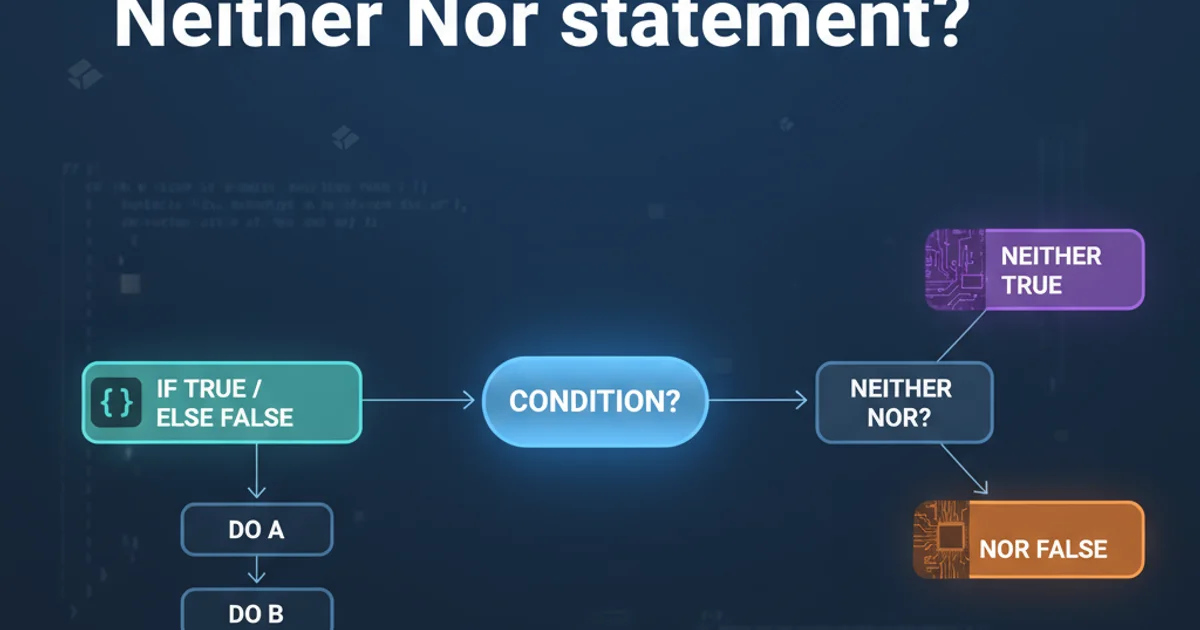There is an if-else, is there a Neither Nor statement?
Categories:
Beyond If-Else: Exploring 'Neither-Nor' Logic in C++

Dive into the nuances of conditional logic in C++ and discover how to effectively implement 'neither-nor' scenarios without a dedicated language construct.
In programming, conditional statements like if-else are fundamental for controlling program flow based on specific conditions. They allow us to execute a block of code if a condition is true, and an alternative block if it's false. However, developers often encounter situations where they need to express a 'neither-nor' condition – that is, a block of code should execute only if none of several specified conditions are met. Unlike if-else, there isn't a direct neither-nor keyword in C++ or most other languages. This article explores how to achieve this logical construct effectively using existing C++ features, focusing on clarity, efficiency, and common pitfalls.
Understanding 'Neither-Nor' Logic
The concept of 'neither-nor' implies that a certain action should occur only when two or more conditions are all false. Mathematically, if we have conditions A and B, 'neither A nor B' is equivalent to 'not A AND not B'. In Boolean algebra, this is represented as !(A || B) or !A && !B. Both expressions are logically equivalent due to De Morgan's laws. Understanding this equivalence is key to implementing 'neither-nor' logic in C++.
flowchart TD
Start --> ConditionA{Is Condition A true?}
ConditionA -- No --> ConditionB{Is Condition B true?}
ConditionA -- Yes --> End
ConditionB -- No --> NeitherNorAction[Execute Neither-Nor Action]
ConditionB -- Yes --> End
NeitherNorAction --> EndFlowchart illustrating the 'neither-nor' logic path.
Implementing 'Neither-Nor' in C++
The most straightforward way to implement 'neither-nor' logic in C++ is by using the logical NOT operator (!) in conjunction with logical AND (&&) or logical OR (||).
bool conditionA = false;
bool conditionB = false;
bool conditionC = true;
// Using !A && !B && !C
if (!conditionA && !conditionB && !conditionC) {
std::cout << "Neither A, nor B, nor C is true (Method 1)" << std::endl;
}
// Using !(A || B || C)
if (!(conditionA || conditionB || conditionC)) {
std::cout << "Neither A, nor B, nor C is true (Method 2)" << std::endl;
}
Two common ways to implement 'neither-nor' logic in C++.
Both methods achieve the same result. The choice between !A && !B and !(A || B) often comes down to readability and personal preference. For a small number of conditions, !A && !B might be clearer, as it directly states 'not A AND not B'. For a larger number of conditions, !(A || B || C || ...) might be more concise, expressing 'it's not true that any of these conditions are met'.
Advanced Scenarios and Best Practices
While simple if statements work for basic 'neither-nor' logic, more complex scenarios might benefit from other constructs or design patterns.
enum class State { Initial, Processing, Error, Completed };
void handleState(State currentState) {
if (currentState != State::Error && currentState != State::Completed) {
std::cout << "State is neither Error nor Completed. Current state: " << static_cast<int>(currentState) << std::endl;
// Perform actions for non-terminal states
} else {
std::cout << "State is either Error or Completed. Current state: " << static_cast<int>(currentState) << std::endl;
}
}
int main() {
handleState(State::Initial);
handleState(State::Error);
return 0;
}
Using 'neither-nor' logic with enum class for state management.
Another approach for handling multiple exclusive conditions, especially when different actions are associated with each, is to use a series of if-else if statements, with the 'neither-nor' case falling into the final else block.
void processInput(int value) {
if (value == 1) {
std::cout << "Value is 1." << std::endl;
} else if (value == 2) {
std::cout << "Value is 2." << std::endl;
} else if (value == 3) {
std::cout << "Value is 3." << std::endl;
} else {
// This is the 'neither 1, nor 2, nor 3' case
std::cout << "Value is neither 1, 2, nor 3. It is: " << value << std::endl;
}
}
int main() {
processInput(1);
processInput(5);
return 0;
}
Using if-else if-else to capture a 'neither-nor' default case.
&& or || operators. If your 'neither-nor' condition involves more than 3-4 sub-conditions, consider refactoring them into a helper function or using a more structured approach like a switch statement (if applicable) or a strategy pattern to improve readability and maintainability.